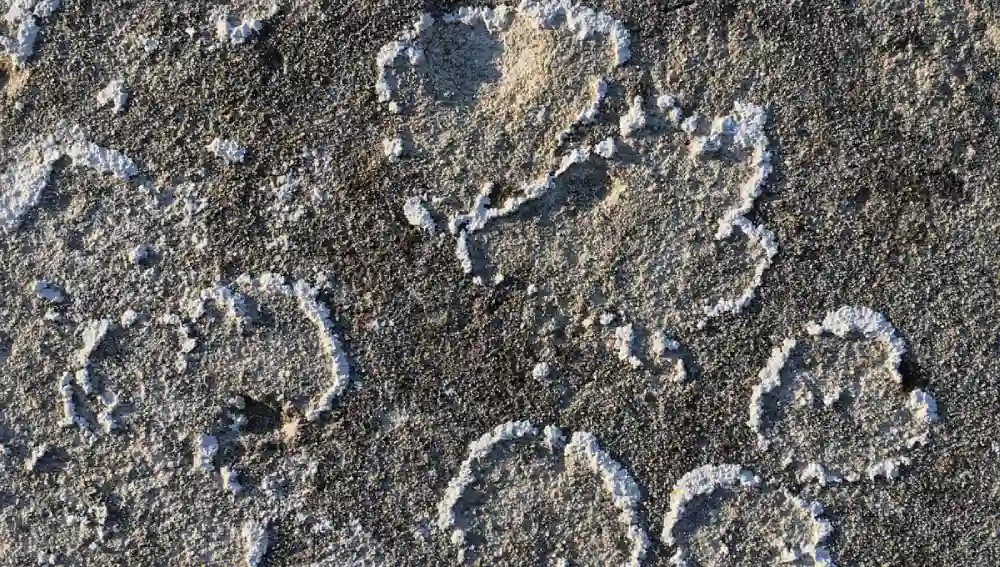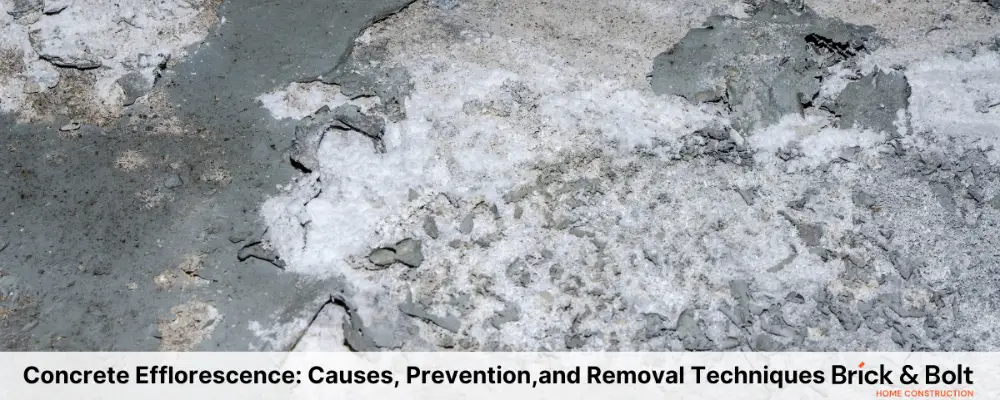The porous building materials like concrete, pavers, and other masons are all prone to efflorescence. It is a chalky mineral deposit that appears on the surface. Although concrete efflorescences will not cause damage to the concrete, it cause unsightly blemishes. In most cases, these can be easily removed using appropriate cleaning methods and tools.
This blog will help you understand the efflorescence in concrete, its causes and effects, and how to remove them in detail.
What is Efflorescence?
Efflorescence in concrete is the formation of white powdery deposits on the surface because of salt leaching. These salts are normally present in the concrete mix and can be made in contact with water. This is mainly because of the evaporation of water from the concrete. It is caused by the water-soluble salts that are present in the concrete material coming to the surface when the water evaporates from the concrete. The charge will travel through the salt bridges and appear on the surface of the concrete. Efflorescences are normally washed away on unsealed concrete surfaces; if that is stubborn, then a mild acid wash or even a light sandblasting can be used for removal. Efflorescence that is trapped under the sealer will become unsightly, and it is even more conspicuous if the floor colour is dark.
In some worst-cases, gases that cannot pass through the top coat, like urethane or epoxy, can create water blisters because of the hydrostatic pressure that indicates the delamination of the top coat from the concrete. In the case of acrylics, you can rarely see the blisters, as acrylic sealers will allow the vapour to pass through them, but the salt deposits may remain behind, which can create an unsightly appearance.
Causes of Efflorescence
The presence of soluble salt in one concrete material can cause efflorescence. Commonly, salts can be identified in the fine aggregate or sand taken from the river banks.
- If the concrete is not cured properly, then it will lead to an incomplete hydration process that may result in unhydrated products near the surface that can form efflorescence.
- If the rate of water evaporation is slow, then it will allow the charge to permeate to the surface. This is the reason efflorescence tends to be more of a problem during the winter months than compared to that of the summer months. This is because in summer, due to high temperatures, evaporation takes place, and salt deposits occur within the concrete and not on the surface of the concrete.
- The concrete will be porous if the water content in the concrete mix is higher. This will make a path for water and salt to come to the surface and cause efflorescence.
- In conditions like rainy seasons, there will be a large amount of water that can act as a medium for the salt to be transported to the surface of the concrete and form a crystalline white powder.
- Any variability in the concrete, like compaction or curing issues, can result in localised problems where the water can permeate more easily through the concrete.
- Water infiltration into the concrete, mainly in areas with poor drainage systems, can dissolve the salt and transport it to the surface.
- If the humidity level is high, then it can lead to continuous dissolution and migration of salt within the concrete.
Salt Types in Efflorescence
- Calcium sulfate: Brick
- Sodium sulfate: Cement brick
- Potassium Sulfate: Cement brick
- Calcium carbonate: Mortar or concrete backing
- Sodium carbonate: Mortar
- Potassium carbonate: Commonly found in mortar
- Vanadyl sulfate: Bricks
- Manganese oxide: Brick
Signs of Efflorescence

- A visible white or greyish powder deposit is found on the surface of the concrete.
- Crystalline structure formation on the surface of the concrete commonly resembles the salt-like pattern.
- Presence of any stain or discolouration on the concrete that is caused by the deposition of salt.
- Sometimes efflorescence may lead to a rough or gritty texture on the surface of concrete.
- In the case of severeness, the surface may start to flake or peel due to the growth of crystallines.
Prevention of Efflorescence
- To lock in the significant amount of calcium hydroxide in the concrete, you can include class F fly ash or metakaolin.
- A vapour barrier must be installed to prevent moisture movement from the subgrade to the surface of the slab.
- To prevent the surface water from penetrating the slab, the application of sealings or coatings can be made.
- Waterproofing agents can be used to reduce the permeability of the concrete.
- The permeability of the concrete can be greatly reduced when dense concrete is made and used.
- Placing a plastic membrane under the slabs can prevent the hardening of concrete from exposure to moisture, and the surface can be maintained by using surface sealants or site drainage.
- By preventing the concrete from premature drying.
- By using concrete materials like aggregate, cement, and sand that have a very low amount of salt.
- Maintaining a proper water-to-cement ratio in the concrete mix can prevent excessive water that can dissolve and transport salt.
- By using clean, noncontaminated water for mixing and curing the concrete, you can prevent the introduction of additional salts.
- Water can be prevented from ponding on the surface of the concrete, mainly during the curing period.
- By following the best construction practices that include proper drainage design and protection of the concrete at the time of construction to prevent water infiltration.
By addressing these factors during the construction process, you can significantly reduce the chances of efflorescence structures of concrete.
Removal of Efflorescence in Concrete
The sources of the efflorescence must be identified before removing it from the concrete. The removal can be done in three methods, namely,
Pressurized water
Efflorescence The concrete can be removed by using pressurised water jets. The efflorescence can be dissolved faster by applying the pressurised water. However, they must care about the water after completely removing the efflorescence. If it is not properly used, the same water may become the cause of efflorescence.
Brushing
Some types of efflorescence can be easily removed when a stiff bristle broom or brush is used. If the result is not up to the mark, then scrub it with clean water and slightly rinse the surface.
Dilute acid solutions
Commonly concentrated acids are not recommended to be applied on the surface of the concrete; hence, the diluted version of the acid with a proportion of 1:20 can be used. The surface on which the acid is applied must be moist, but it should not have any free water. The applied solution will be able to react on the surface of the concrete for about 10 to 15 minutes. Then the surface must be completely washed and scrubbed with water. Washing it repeatedly for at least twice or until all the traces of acid solution are removed is essential.
Using the acid to wash may lead to variations in colours and change the surface texture. For surfaces that have coloured finishes, more diluted solutions of two percent or one part of acid to 50 parts of water may be needed. First, a small trial area must be checked for results.
Proper safety must be followed during the procedure. Make sure to have good ventilation and avoid contact between the acid and the reinforcement.
Acids that can be used for the removal of efflorescence in concrete surfaces,
- Phosphoric acid
- Hydrochloric acid
- Prepacked efflorescence removers
How to Repair Efflorescence in Concrete?
Clear water repellents, along with acrylic coatings and silicone coatings, can assist in preventing the recurrence of efflorescence. Additionally, the combination of white wine vinegar and warm water has been shown to have an effect on the removal of efflorescence. Application steps involved in coating for prevention of efflorescence in concrete are,
- Clean the surface area.
- Use chemical cleaning methods when necessary.
- Rinse the surface thoroughly to neutralize the acid and remove the remaining acids.
- Dry the surface before applying any sealers or coatings.
- Apply a breathable sealer to the surface of the concrete.
- Identify and address the main cause of water infiltration.
- Repair the cracks in the concrete to prevent water penetration.
- If possible, consider using efflorescence-resistance concrete mixes.
Conclusion
If there is any occurrence of efflorescence, then be careful and make your systematic approach of cleaning, sealing, and addressing the underlying issues that can help in the restoration of the concrete appearance and also prevent further problems. Regular checking and maintenance are important for making sure that concrete can be durable for a long time and the visual appearance can be maintained. By combining the strategies, the impact of efflorescence can be reduced, and this allows the structures not only to stand the test of time but also to maintain their aesthetic quality.
FAQs
No, it can usually be cleaned off and prevented with proper maintenance.
It can return if the underlying moisture problem isn’t addressed.
Yes, if there’s moisture inside the building, it can still occur.
Yes, it’s more common in new concrete because the salts are still near the surface.

